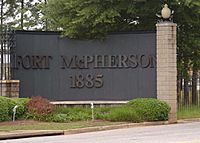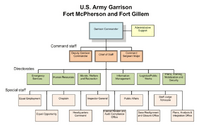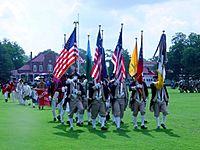Fort McPherson facts for kids
Quick facts for kids Fort McPherson |
|
|---|---|
| Atlanta, Fulton County, Georgia, U.S. | |

The front gate of Fort McPherson
|
|
| Type | Army post |
| Site information | |
| Owner | |
| Controlled by | |
| Site history | |
| Built | 1885 |
| In use | 1885–2011 |
| Garrison information | |
| Garrison | U.S. Army Forces Command U.S. Army Reserve Command U.S. Army Central Installation Management Command, Southeast Region |
Fort McPherson was a historic U.S. Army base located in Atlanta, Georgia, right next to the city of East Point, Georgia. For many years, it was a very important place for the U.S. Army in the southeastern United States. It served as the main office for several major Army commands, including the U.S. Army Forces Command and the U.S. Army Reserve Command.
The fort covered about 487 acres (almost 2 square kilometers) and was located just four miles (6 km) southwest of downtown Atlanta. Its history as an Army post goes all the way back to 1867. Back then, a smaller post was set up in west Atlanta, where Spelman College is now. Soldiers from different U.S. Infantry Regiments were stationed there to help enforce rules during the time after the Civil War, known as the Reconstruction period.
The fort was named after Major General James B. McPherson, a brave Union Army general who was killed during the Battle of Atlanta in 1864. The Army first bought the land for the fort in 1885 to station ten Army companies there.
During World War I, Fort McPherson was used for several purposes. It held prisoners of war from the Imperial German Navy and was a training ground for soldiers. A special rifle range was set up, and soldiers even studied local Civil War trenches to learn about trench warfare.
In 1934, during a big textile workers' strike, the fort was used to hold people who had been arrested while protesting at a cotton mill.
Fort McPherson also had a "sister" base called Fort Gillem, located about 11 miles (18 km) away in Forest Park, Georgia. Fort Gillem helped with supplies and housed other important Army offices. Both forts shared many services. In 2007, over 2,400 active duty soldiers and nearly 3,800 civilian employees worked at both forts. Most of these military and civilian families lived in homes outside the bases in the surrounding counties.
For public transportation, Fort McPherson was mainly served by the Lakewood/Fort McPherson MARTA (Metropolitan Atlanta Rapid Transit Authority) station.
In 2015, a large part of the former Fort McPherson land was bought by actor and producer Tyler Perry to build his Tyler Perry Studios. The studios officially opened in October 2019.
Contents
- Fort McPherson's Closure
- Important Army Units at Fort McPherson
- Installation Management Command, Southeast Region
- U.S. Army Forces Command
- U.S. Army Reserve Command
- U.S. Army Central
- Army Ground Forces Band
- First Army
- 52nd Explosives Ordnance Group
- Military Entrance Processing Station
- Headquarters, 3d Military Police Group (CID)
- United States Army 2nd Recruiting Brigade
- History of Fort McPherson
- Annexation by Atlanta
- Headwaters of Utoy Creek
- Images for kids
Fort McPherson's Closure
In 2005, the government decided to close or reorganize many military bases across the U.S. This process was called BRAC 2005 (Base Realignment and Closure). As a result, Fort McPherson was officially closed on September 15, 2011. Fort Gillem was also made much smaller, becoming a military "enclave."
Units Moving Out
When Fort McPherson closed, many important Army units had to move to new locations:
- The main offices of the U.S. Army Forces Command and the U.S. Army Reserve Command moved to Fort Bragg, North Carolina.
- The main office of United States Army Central moved to Shaw Air Force Base in South Carolina.
- Other commands, like the Installation Management Command, Southeast Region, moved to Fort Eustis, Virginia.
Units from Fort Gillem also moved:
- First United States Army moved to Rock Island Arsenal, Illinois.
- The 52nd Ordnance Group (EOD) (Explosive Ordnance Disposal) moved to Fort Campbell, Kentucky. This group deals with bombs and other dangerous explosives.
What Happened to the Land?
After the closure, plans were made to reuse the land from both Fort McPherson and Fort Gillem.
Fort Gillem's New Purpose
The plan for Fort Gillem was to create new jobs and improve the area. It was mostly planned for light industry and logistics (like warehouses and shipping), with some shops and homes.
Fort McPherson's New Purpose
A special group called the McPherson Planning Local Redevelopment Authority (MPLRA) was in charge of planning for Fort McPherson's future. They bought the land for about $30 million. Their plan, approved in 2007, included:
- A large area (about 115 acres) for a biomedical research park. This would be a place for science and technology companies, possibly with parts of the Georgia University system.
- A mixed-use area (about 35 acres) with shops, restaurants, offices, and homes, designed to feel like a "Main Street."
- A historic district (about 40 acres) that would preserve many of the old buildings already listed on the National Register of Historic Places. This area would keep its historical feel.
- Space for up to 4,600 new homes, including different types of housing.
- About 150 acres (0.6 square kilometers) set aside for green space and parks. This would connect to the historic area and create a large park for public events.
As mentioned earlier, a big part of Fort McPherson was later sold to Tyler Perry for his film studios.
Important Army Units at Fort McPherson
Before its closure, Fort McPherson was home to several key Army commands.
Installation Management Command, Southeast Region
This command, known as IMCOM-SE, was responsible for managing Army bases in the southeastern U.S. and Puerto Rico. They handled everything from housing and family support to public works and environmental care. They made sure soldiers, their families, and military units were ready for their missions.
U.S. Army Forces Command
U.S. Army Forces Command (FORSCOM) was the largest command in the U.S. Army. Its job was to prepare and provide soldiers and units for missions all over the world. This included active duty soldiers, as well as the Army National Guard and Army Reserve. FORSCOM made sure these forces were trained, equipped, and ready to respond to crises, whether it was fighting wars or helping with natural disasters.
U.S. Army Reserve Command
The U.S. Army Reserve Command (USARC) managed about 191,000 U.S. Army Reserve soldiers and 10,000 civilian employees. Army Reserve units often provide special support, like medical help, transportation, and engineering. Since 2001, many Army Reserve soldiers have been called to duty to support missions in places like Afghanistan, Iraq, and Kuwait.
U.S. Army Central
U.S. Army Central (USARCENT) was the Army's main command for the Middle East and South and Central Asia. It was ready to lead ground forces in these important regions. USARCENT, also known as Third Army, has a long history, serving in World War I, World War II, and the Gulf War. It played a huge role in the 1990-1991 Persian Gulf War, overseeing over 338,000 coalition forces. More recently, USARCENT commanded ground forces in Afghanistan in 2001 and in Iraq in 2003.
Army Ground Forces Band
The 214th Army Band, also known as "The Army Ground Forces Band," was a special musical group. It had a long history, dating back to 1845. This band was known as the "Musical Ambassador of the American Combat Soldier." They provided music for military events, concerts, and community functions, with different groups like a marching band, a concert band, and a rock band.
First Army
First Army was a major command at Fort Gillem. Its main job was to train and prepare Army National Guard and Army Reserve units in 27 states east of the Mississippi River. They helped these units get ready for missions and supported their deployment. First Army also helped with homeland defense, meaning they planned how the military would support local authorities during natural or man-made disasters.
52nd Explosives Ordnance Group
The 52nd Explosives Ordnance Group (EOD) was based at Fort Gillem. Their critical mission was to deal with dangerous explosives, including bombs and improvised explosive devices (IEDs). They worked to protect soldiers and civilians from these threats.
Military Entrance Processing Station
The Atlanta Military Entrance Processing Station (MEPS) was one of 65 MEPS locations across the country. This is where young men and women go to join the military. The Atlanta MEPS tested, medically evaluated, and processed almost 7,000 people each year who wanted to join the Army, Navy, Air Force, Marines, or Coast Guard.
Headquarters, 3d Military Police Group (CID)
The 3d Military Police Group (Criminal Investigation Division), or 3d MP Group (CID), was located at Fort Gillem. This group was responsible for investigating serious crimes for the Army across many states and even in Central and South America. They also worked with other law enforcement agencies and helped protect important military officials.
United States Army 2nd Recruiting Brigade
The U.S. Army 2nd Recruiting Brigade, based at Fort Gillem, managed nine recruiting battalions across the southeastern U.S. Their job was to help people learn about joining the Army and guide them through the recruiting process.
History of Fort McPherson
Early Days
Fort McPherson's military history began in 1867. The first post was set up in west Atlanta to help enforce Union rules after the Civil War. In 1881, this first post was closed and sold. However, the Army bought new land in 1885 to build a larger, permanent post. This new post was named after Major General James Birdseye McPherson, a Civil War hero. He was killed during the Battle of Atlanta in 1864, making him the highest-ranking Union officer killed in that war.
During the Spanish–American War in the late 1800s, Fort McPherson became a hospital and a training center for nearly 20,000 soldiers. It also held Spanish Army prisoners of war.
World War I and II
During World War I, Fort McPherson was a camp for German prisoners of war and a major hospital. It could hold almost 2,400 patients, and over 10,000 injured soldiers were treated there between 1917 and 1918.
In the 1930s, the fort's hospital grew even more, becoming a rehabilitation center. It also served as a headquarters for the Civilian Conservation Corps, a program that put young men to work on public projects during the Great Depression.
When World War II began in 1940, Fort McPherson became very busy. It was a major center for processing thousands of men joining the military and continued to be a large hospital. After the war ended in 1945, the fort became a "separation center," helping almost 200,000 soldiers return to civilian life.
Historic Buildings
Many of the old buildings at Fort McPherson are part of a historic district and are listed on the National Register of Historic Places. Here are a few examples:
Hodges Hall
Hodges Hall (Building 65) was built in 1904 as a barracks for soldiers. It has a unique horseshoe shape. It was named after General Courtney Hodges, who commanded the Third and First U.S. Armies during World War II. This building later became the main headquarters for the fort.
Troop Row
Construction on Troop Row began in 1889. These buildings were originally barracks where soldiers lived. Today, they have been changed into office spaces.
Post Chapel
The chapel (Building 42) was built between 1886 and 1889. Interestingly, it was first used as the post guardhouse and even held prisoners during the Spanish-American War. In 1921, it was turned into a chapel with pews and beautiful stained-glass windows.
Hospital
The original post hospital (Buildings 170 and 171) was built around the same time. It became so important during World War I that the head medical officer was in charge of the entire post. Many other buildings, including those on Troop Row, were used as hospital wards during the wars.
Staff Row
Staff Row consists of 19 homes for officers, built between 1891 and 1910. These homes were designed for officers and their families. The last home built on Staff Row, in 1910, became the residence of the post commander.
Hedekin Field
Staff Row faces a large open area called Hedekin Field, which was originally a polo field. It's named after Captain David Drew Hedekin, a polo player who was injured and died playing the sport in 1938. Today, this field is used for parades, ceremonies, and other special events.
Quarters 10
Quarters 10 is a very grand three-story home on Staff Row, completed in 1892. It has very high ceilings and unique semicircular windows. Famous generals, like General Douglas MacArthur, were assigned to live here, though he chose to live downtown for a short time. A sleeping porch was even added for President Franklin D. Roosevelt when he visited on his way to Warm Springs, Georgia.
Annexation by Atlanta
Fort McPherson was always closely connected to the East Point community, even using its post office for many years. In 1941, the City of Atlanta officially took over (annexed) most of the fort. A highway built in 1964 further separated parts of the fort.
Headwaters of Utoy Creek
Natural springs within the fort's area are one of the starting points for South Utoy Creek, which flows northwest to the Chattahoochee River.
Images for kids







